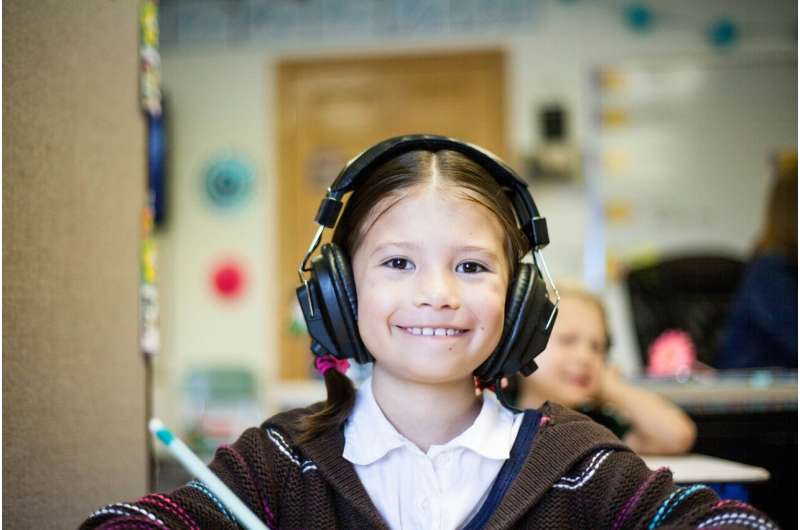This article has been reviewed according to Science X's editorial process and policies. Editors have highlighted the following attributes while ensuring the content's credibility:
fact-checked
peer-reviewed publication
trusted source
proofread
White, pink noise improve focus for children with ADHD, study shows

Oregon Health & Science University researchers are uncovering the potential benefits of color noise exposure for young people with attention-deficit/hyperactivity disorder, or ADHD.
A study published in this month's issue of the Journal of the American Academy of Child & Adolescent Psychiatry found a small but statistically significant benefit of white and pink noise on task performance among children and college-age young adults with ADHD.
Color noises represent a different combination of frequencies and volumes along the spectrum of sound, each with their own distinct characteristics and effect on the brain. Just as white light includes all the colors of the rainbow, white noise contains all frequencies of noise and sounds like static. Pink and brown noise are similar, but with a higher proportion of low frequencies; they may sound like rain or a waterfall.
As clinical understanding of ADHD continues to broaden, interest in identifying novel, low-cost supports for those diagnosed with the condition has grown. One such support that has recently sparked great interest is the potential use of color noise exposure—including white, pink and brown noise—to enhance focused performance during attention-demanding tasks.
"Although outcomes are much improved with current treatments, ADHD still can dramatically increase the risk of serious and complex long-term health outcomes, because treatments are only partially effective, and adherence is difficult," said Joel Nigg, Ph.D., professor of psychiatry in the OHSU School of Medicine, co-director of the OHSU Center for Mental Health Innovation and lead author of the study. "It is critical that we continue to investigate complementary and alternative supports for those living with ADHD.
"Our priority is identifying new and improved tools to empower each individual to live their healthiest and most productive life, as well as providing evidence-based guidance on popular ideas in the public domain such as white or brown noise."
Exploring color noise
The systematic review and meta-analysis included 13 studies with 335 participants. It found that either white or pink noise improved cognitive performance for children and young adults with ADHD or significant ADHD symptoms. In contrast, either white or pink noise slightly reduced cognitive performance for individuals without ADHD or with normal attention.
Researchers say these results point to a possible low-cost, low-risk intervention that may benefit youths with ADHD. Leveraging white and pink noise is relatively safe, easy to implement and accessible, Nigg said. Additionally, color noise therapies can be used inexpensively at home and in concert with other interventions, like medications, with relatively low concern for side effects.
At the same time, however, use of color noise to enhance attention is not without hazard, Nigg cautioned. Damage to hearing is a significant risk if noise volumes are not carefully monitored, and other studies have shown that youth tend to use headphones at excessive volumes for other activities. Effects of frequent use on children's attention development are also unknown.
With these unknowns, creation of clinical guidelines would require additional data, Nigg said. Looking ahead, researchers will need to prioritize additional studies that compare white or pink noise with other environmental stimulation—such as brighter light or other kinds of noise—and test the range of effect across task types and with varying types and durations of auditory stimulation.
Additionally, study populations should be expanded and diversified to ensure accurate data is collected on race, ethnicity, and other characteristics that may influence effects, Nigg said, noting that the lack of a large, diverse sample population was a major limitation of the study.
"While additional research is needed to translate the findings to clinical practices, these initial results should be seen as encouraging," Nigg said.
"The results should stimulate further work to clarify who can benefit and what dosages and amounts are safe and appropriate. Supportive interventions continue to be needed for ADHD, which affects millions of kids and adolescents around the world."
More information: Joel T. Nigg et al, Systematic Review and Meta-Analysis: Do White Noise or Pink Noise Help With Task Performance in Youth With Attention-Deficit/Hyperactivity Disorder or With Elevated Attention Problems?, Journal of the American Academy of Child & Adolescent Psychiatry (2024). DOI: 10.1016/j.jaac.2023.12.014





















